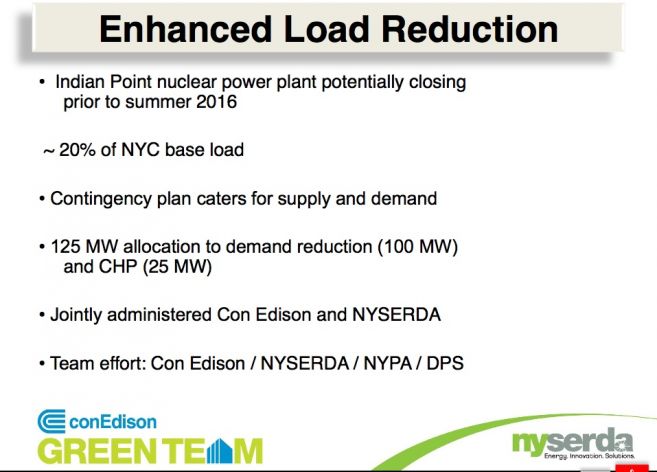Grid-scale energy storage is coming to New York City.
With the looming closure of the 2-gigawatt Indian Point nuclear reactor, New York City utility Con Edison has submitted a proposal to furnish 100 megawatts of load reduction measures that include energy storage, demand response and energy efficiency.
Con Edison and NYSERDA have released some of the initial details about the program, noting that they are subject to change.
The new incentives for energy systems that provide summer on-peak demand reduction are $2,600 per kilowatt for thermal storage and $2,100 per kilowatt for battery storage systems, with bonus incentives for projects larger than 500 kilowatts. Incentives will be capped at 50 percent of the project cost.
Bill Radvak, CEO of American Vanadium, recently wrote in a piece he contributed to GTM: "Last fall, California passed the first statewide energy storage directive in the United States. [...] Next up at the plate as a receptive market for energy storage in North America is New York. Bill Acker, Executive Director of the New York Battery and Energy Storage Technology Consortium, is positioning New York state as a global leader in energy storage technology, including applications in grid storage, transportation and power electronics."
"Last summer, Governor Andrew Cuomo announced a $23 million public-private investment in the creation of a battery storage test and commercialization center in partnership with NY-BEST, which moved state-of-the-art energy storage testing capabilities from Pennsylvania to a facility at the Eastman Business Park in Rochester, New York," noted Radvak.
The proposed New York City incentive bears some resemblance to California's Self-Generation Incentive Program, a subsidy established by California's PUC to support existing and emerging distributed energy resources, which provides one-time, upfront rebates for distributed energy systems installed on the customer's side of the utility meter. In California, qualifying technologies include wind turbines, fuel cells, and associated energy storage systems. Bloom Energy was able to exploit this incentive program for its SOFC fuel cells.
Large grid-scale energy storage has moved from its demonstration and pilot program phase to its early commercialization phase, and California seems to be setting the pace.
Last June, the PUC asked California's big three investor-owned utilities to procure 1.3 gigawatts of energy storage by 2020, along with setting market mechanisms to launch the procurement process.
The recent 50-megawatt Southern California Edison Los Angeles Basin Energy Storage RFQ reveals a California utility industry that is starting to understand the deployment of big energy storage. The SCE solicitation was notable for the effort taken to identify the true value of grid-scale energy storage. In the words of John Zahurancik, VP of Deployment and Operations at AES Energy Storage, "The Edison RFQ is the first formal recognition by a state that [energy storage] absolutely has value."
Imperial Irrigation District (IID), a municipal utility that provides power and water services to about 150,000 customers in the southeastern part of California's desert, just took a step toward deploying energy storage with the issuance of QR 123, the start of a solicitation for 20 megawatts to 40 megawatts of battery storage. IID is also the third-largest public power utility in the state and the nation’s largest irrigation district. The utility wants "respondents to design, engineer, procure and construct a utility-scale energy storage project" and specifies that it is a "battery" storage project. At this stage, the utility is simply looking at vendor qualifications and getting input from companies including A123 Systems, Black & Veatch Renewables, Borrego Solar Systems, Clairvoyant Energy, Coachella Energy Storage Partners, EnerVault, Prudent Energy, S&C Electric and Stem.
California is home to several large-scale energy storage projects funded by DOE grants. PG&E is building a 300-megawatt, ten-hour CAES system in the Central Valley, and SCE has been working with LG Chem on an 8-megawatt, 32-megawatt-hour lithium-ion battery warehouse in the Tehachapi mountain range. Both projects are aimed at stabilizing and integrating the state’s wind power resources into the grid.


***
Looking for more information on energy storage? GTM Research’s report, Grid-Scale Energy Storage in North America 2013: Applications, Technologies and Suppliers, pinpoints the most promising energy storage applications, geographic markets and market segments and profiles over 150 companies active in the North American grid-scale storage industry.
GTM Research also analyzes the commercial energy storage market in its newest report, Distributed Energy Storage 2014: Applications and Opportunities for Commercial Energy.



